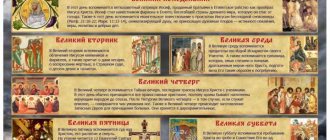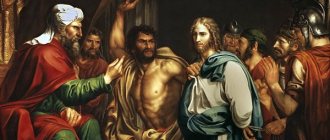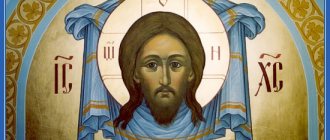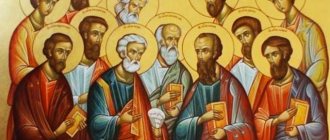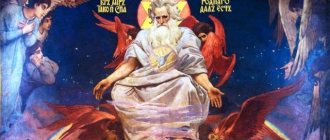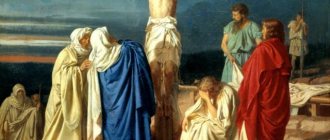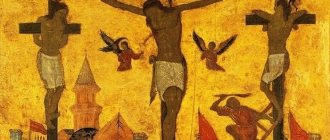Everyone who has read the Holy Gospel knows that Jesus Christ, being the only begotten son of God, was incarnated as a man from the Holy Spirit, who descended on the Virgin Mary.
His life and ministry are described in sufficient detail by the evangelists. But his death and subsequent Resurrection is what was predicted in the Old Testament. Why did this have to happen? How did all the cause and effect come together so that all the predictions about Jesus Christ came true?
These are very difficult questions. To answer them, you need to turn to the only truthful source - the Holy Gospel.
The reason why Jesus Christ was crucified
Photo: Flickr.com
The Gospel of Matthew says:
At that time they had a famous prisoner called Barabbas;
So, when they had gathered, Pilate said to them: whom do you want me to release to you: Barabbas, or Jesus, who is called Christ?
for he knew that they had betrayed Him out of envy.
While he was sitting in the judgment seat, his wife sent him to say: Do not do anything to the Righteous One, because now in a dream I have suffered a lot for Him.
But the chief priests and elders stirred up the people to ask Barabbas and to destroy Jesus. Gospel of Matthew (Matthew 27:15–26)
That is, the reason is clearly indicated to us: out of envy.
The people who listened to Christ's sermons when he taught him in the temple accepted his teaching with their hearts. It was so true that people were willing to go any distance to hear His preaching. They followed Jesus, listening to Him and accepting him as the Messiah. In addition, all those miracles that he showed people, healing the sick, raising the dead, feeding thousands of people with five loaves, indicated that he was not just another preacher, but exactly who he calls himself - the Son of God.
Because of his activities, the scribes and Pharisees lost their influence before our eyes, and, therefore, their income. The opportunity to increase their storehouses, decorate their robes, recline at feasts and sit in synagogues floated away from them. Now it was not them, but Jesus Christ who were greeted by the people's assemblies. He was called the Teacher, not the scribes and Pharisees. This was precisely the reason that envy and anger strangled the former authorities for the people.
And since the scribes and Pharisees lived among the people for many years, knew their weaknesses and vices, which they themselves instilled in the people, it was not difficult for them to press on the right strings.
The Lord saw everything in advance, he knew about his fate, but gave the Jews the right to choose between good and evil. And they chose a cross for him, shouting in unison “Crucify, crucify.”
Envy and malice are the reasons indicated in the Gospel itself that led Jesus Christ to Calvary.
Resurrection of Christ
The next morning, a girl named Mary Magdalene, who loved the Lord, came to the cave. She saw that someone had moved the stone and now the passage there was open. She quickly entered the cave. She approached the tomb where the Savior was supposed to lie, but he was not there. Where did Jesus go?
The girl began to cry. And suddenly I saw two young men. They were dressed in white robes and sat at His resting place.
They asked:
- Girl, why are you crying?
- How can I not cry if yesterday the best person on earth died, and today someone took His body away? – said the inconsolable Maria through tears. She had never seen Angels before, and the young men were Angels.
Behind her, she heard footsteps approaching. The virgin turned around and saw a stranger. She immediately got angry because no one entered the cave after her.
She addressed him with the words:
- Did you take Him? Tell me where you took Him!
The man said:
- Maria!
And then the girl recognized Him. It was Jesus, her Teacher. Only He didn’t look like that tortured Christ. A strong, healthy man stood in front of her. So he's alive!
- Go and tell the others what you saw!
The girl ran out of the cave and headed into the city with a smile on her face. Entering the house where His disciples were grieving, she said with genuine joy:
- Stop crying! The Savior has risen!
WE RECOMMEND: Prayer of gratitude to the Lord God for everything.
Questions for the priest
Hello! Please tell me how to explain to a child that Mary Magdalene was a harlot? Is it even worth discussing such a difficult topic with a child? He has questions, but he doesn’t want to lie about her. The baby is 5 years old.
It is too early for a child to know such details. You should talk about this closer to adulthood. To begin with, say that Mary Magdalene was a bad woman, but after meeting Christ she began to change for the better and became good. I think this answer will satisfy the child.
We have a baptized son. Always wears a cross. He is 7 years old. Lately, he began to look at it carefully, and yesterday he came up and said: “Mom, there’s a tired uncle on my cross, who is that?” I could answer that this is Christ, but please give me recommendations on how best to do this?
: Your child’s question is natural. All children sooner or later wonder about them, as they are inquisitive from birth. I suggest doing it the way you wanted. Tell us a little about Christ, why he was tormented. Bring up the topic of the crucifixion. This way the baby will understand why God the Son suffers.
Yesterday after school, our first grader started asking about the crucifixion. There was a thematic lesson at school where they talked about the life path of Christ. Our child stated that Jesus was a criminal, which is why He was nailed to the cross. My husband and I are afraid for our child; he has the wrong understanding of things. What to do?
In general, since there was a thematic lesson at school, everything had to be explained in detail. If this does not happen, then talk to your baby. Your task is to explain to him that Christ is not a criminal, he was slandered and made one. To make the example clear, ask your child to remember if he has ever been deceived so that another person (or him) would be thought poorly of. I think he will be able to draw his own conclusions and understand that Jesus is not a criminal.
This afternoon my father, my daughter’s grandfather, passed away. We haven’t talked about this yet, but my daughter is starting to guess. My wife and I understand that a conversation needs to be had, but we don’t know how. Please give advice! The daughter loved her grandfather very much. In the summer they planned to go to the forest to pick strawberries, she is really looking forward to it, and we don’t know how to tell her that she won’t go anywhere. My daughter is 9 years old.
I sympathize with your grief. The loss of loved ones is always unexpected, especially for children. They experience this more difficult than adults. The conversation must take place! As an example, you can draw an analogy with the Resurrection of Christ. Tell her about this plot. She must understand that a person does not die forever. He is always in the hearts of those who remember him. He will never die, and if you live righteously, honestly and according to your conscience, there will be a chance to meet him again.
Predestination
Photo: School.orthpatr.ru
But, as already said, the death of Christ was predetermined from the beginning; he had to die in order to cheat death. It was a way to cure humanity of original sin. The Lord knew what he had to endure in order to atone for the sins of mankind. That’s why he calls himself the son of man, emphasizing that he will suffer like a man, but having died, he will be resurrected.
And thus, to every person consisting of flesh and blood, God gave hope that resurrection awaits him, but at the same time, the main thing is to preserve his immortal soul from sin. That is why believers do not lose heart when reading the description of the terrible torment of the Lord. They just have to prevent them from happening again. But every time people sin, they again send Jesus Christ to the cross, making his atoning sacrifice meaningless.
Terrible execution
The torture of the cross was not only the most terrible, but also the most shameful execution. She came to the Roman Empire from Carthage, and there, in turn, penetrated from Phenicia. The Romans never executed citizens in this way - only slaves.
Interesting fact
After the defeat of Spartacus in 73 BC. 6,000 rebels were crucified. And the crosses stood along the longest Appian Way for 195 km.
However, sometimes in Rome they made an exception for the worst criminals. Such executions were carried out as an edification to other villains, so that, fearing the torment of death, they would stop their dark deeds. Not all crosses were the same as the one on which Christ was crucified; other forms were also used:
- T-shaped;
- X-shaped;
- Y-shaped.
Most often they crucified with their heads down, because it was more convenient - a long pole was stuck deep into the ground, and the transverse bar turned out to be quite low.
There are several versions of how exactly the execution itself took place. According to one of them, the executed themselves carried its instruments - crosses - to the place of their death, according to the other - only the crossbar, while the pillars were installed in advance.
In some cases, the hands were not nailed down, but tied with ropes. But more often they used nails. They were driven not into the palms, since they would not have supported the weight of the body, but into the wrists. The legs were also nailed down. The crosses never had a crossbar, because if there was one, the meaning of the terrible execution would be lost. The victims on the cross died not from blood loss or pain, but from suffocation - precisely because there was no support under their feet.
Flagellation of Christ, Desecration of Christ, Procession to Golgotha, Ascension to the Cross
Before execution, they were usually scourged. Then they had to carry the transverse part of the cross to the place of crucifixion.
To prevent death from painful shock, those sentenced to execution were offered wine with opium. But, as the Gospel of Mark says, Jesus rejected the offering, and therefore suffered more than others.
“And they gave Him wine and myrrh to drink; but He did not accept.” (Mark 15:23)
A blow to the rib with a spear was not applied to finish off, but posthumously, as proof of the fact of death.
The people did not wait for the Messiah
Photo: Radiovera.ru
Why did those people who followed the Lord in crowds, saw the miracles that He performed for them, suddenly turn away from him so easily? Why didn’t they shout down the crowd that was sending Him to death?
Perhaps, and this is one of the versions, He did not live up to their expectations. The Jews believed that He was the Messiah who would become a leader, free Israel from the power of the pagans, make it great and the whole world would respect their state. But instead of taking power from King Herod by force and expelling the Romans who enslaved the Israelites, Christ called the Jews to repentance and prayer. He preached humility and mercy, not war and violence.
As a result: those who a few days ago at the entrance to Jerusalem shouted “Hosanna to the son of David”, a few days later shouted “Crucify, crucify Him!” at the palace of the governor Pontius Pilate.
Gospel account of the Crucifixion of Christ
Each of the evangelists tells a story about the last days and hours of the Savior on earth. The apostles agree on the main points, although the details differ.
Stills from Mel Gibson's film "The Passion of the Christ"
Thus, in all four texts it is written that when Jesus was led to execution, the cross behind Him was carried by a certain Simon, whom he met on the road and was returning, as Mark mentions, from field work. On Golgotha they crucified Him, and next to them were two criminals. One blasphemed Him along with the scribes, Pharisees and other onlookers. They spoke:
“Why doesn’t God save you if you are His son? Prove to us, come down from the cross!”
The soldiers who were near those executed shared Jesus’ vestments. A few hours later the Savior died.
These are facts that are, to a greater or lesser extent, stated in all the Gospels. But each of the students added their own details.
For example, Luke mentions that Jesus, as He was being led to execution, addressed the women, saying:
“Daughters of Jerusalem! Do not weep for Me, but weep for yourself and for your children, for the days are coming in which they will say: Blessed are the barren, and the wombs that have not given birth, and the breasts that have not nursed!” (Luke 23:28-29)
And John talks about how the Savior entrusted his Mother to his care:
“At the cross of Jesus stood His Mother and His Mother’s sister, Mary of Cleophas, and Mary Magdalene. Jesus, seeing His Mother and the disciple standing there, whom He loved, said to His Mother: Woman! Behold, Your son. Then he says to the disciple: Behold, your Mother! And from that time on, this disciple took Her to himself.”
(John 19:26-28)
Epistle of Peter
The Apostle Peter also speaks about the death of Jesus Christ in his letter. He provides evidence that Christ also suffered for the sins of people, being a righteous man, in order to bring unrighteous people to God.
Have a good conscience, so that those for whom you are slandered as evildoers may be put to shame by those who reproach your good life in Christ.
For, if the will of God pleases, it is better to suffer for good deeds than for evil ones;
because Christ, in order to lead us to God, once suffered for our sins, the righteous for the unjust, being put to death in the flesh, but made alive in the Spirit,
to whom He and the spirits in prison, having descended, preached
1 Peter 3 verse 18
Place and date of the crucifixion
The Savior died on a hill shaped like a skull and called Golgotha. The Jews believed that the forefather Adam was buried under the hill. All public executions were traditionally carried out there. The site of the Crucifixion is located in the historical part of modern Jerusalem and belongs to the complex of the Holy Sepulcher. Hundreds of thousands of pilgrims come here every year.
The site of Christ's crucifixion in the Church of the Holy Sepulcher in Jerusalem
But the exact date, and especially the year, are not known for certain.
According to the Gospels, this happened on Friday, the 15th day of the month Nissan, which approximately corresponds to March-April according to the Gregorian calendar.
The Savior rose on Sunday. The question arises: how is this possible if three days passed between the Crucifixion and the Resurrection? Researchers are still arguing about this. In particular, this “miscalculation” is explained by the fact that Jews counted time differently. For the Jews, the day did not begin at midnight, but six hours earlier. The Romans used the Julian calendar. Hence the time difference.
Images
In churches and on the canvases of artists, the Crucifixion is depicted in different ways.
Icon cross “The Crucifixion of Christ with those coming” Second half of the 19th century. Copper alloy, casting, silvering, enamel. 22.1 × 14.1 × 0.4 cm Central Museum of Ancient Russian Culture and Art named after. Andrey Rublev, Moscow, Russia
The traditional symbol of the Russian Orthodox Church is an eight-pointed cross. It can be seen on domes, above the altar, and on eves. The Savior is depicted alive, with his hands nailed to the middle crossbar. The top, small one is the title with the same inscription. The bottom crossbar is a symbol of the scales of good and evil. So, one thief on the cross showed generosity, and the good in his soul outweighed. The second, on the contrary, scolded Jesus, and evil prevailed in his soul.
Traditional Orthodox and Catholic type of image of the Crucifixion of Christ on the Cross Photo Azbuka.ru
Christ was depicted in paintings from different eras, depending on the ideas that existed at that time. Thus, in the early Middle Ages, the Savior was written dead, with his head bowed. In the 13th century. a tradition arose to depict Him wearing a crown of thorns. And in the same century, Jesus in the paintings increasingly appeared suffering, in agony, with blood flowing from his wounds. This is how we see it, for example, on the “Izemkhai Altar” by Matthias Grunewald.
Longinus and Pilate: the choice of fate
Who exactly is this Roman? Centurion. In Russian - centurion. A professional military man whose goal is to make a career in the army by the age of 40–50. She promised quick rise, wealth, prestige. True, only a few managed to climb the steps of this ladder to the very top - the risks were too great.
It was on the shoulders of the centurions that all responsibilities for organizing the daily life of the legion fell. But they enjoyed unlimited power: anyone who tried to defend themselves from the centurion’s blow faced the death penalty.
The same unlimited power, only on the scale of all of Judea, was possessed by another professional Roman warrior - prefect Pontius Pilate. His reign went down in history thanks to unprecedented violence, tax and political oppression and provocations that offended the religious feelings of the Jews. Pilate's contemporary Philo of Alexandria spoke of him as a cruel and corrupt tyrant, guilty of numerous executions without trial. And the Jewish king Agrippa I, in a letter to Emperor Caligula, complained about his “robbery, insults and endless unbearable cruelty.”
And such a person was really scared during the trial of Christ. And not that he allegedly arbitrarily called himself “King of the Jews,” but that He really could have turned out to be the Son of God. In any case, for the pagan Pilate there was nothing incredible in this - in the Roman pantheon there were Aeneas, Hercules, Aesculapius... And now here is Jesus. It turns out he had just scourged the Son of God!
Beheading of St. Longina. Medieval miniature, France
In fact, the Romans usually gave the gods of the conquered territory the same honors as the gods of Rome, and Pilate did not have the slightest desire to quarrel with this incomprehensible God of the Jews. Moreover, he himself declared Jesus innocent. But all the attempts of the prefect to save this Man from the guilty verdict were broken by the frantic cry of the crowd: “Crucify Him!”
And then the cruel, fearless Roman warrior, who could simply order the soldiers to disperse this crowd by force - as he had done more than once, without being embarrassed by how much blood would be shed - only washed his hands. That is, he simply imitated the Jewish ritual of ablution in order to ward off the wrath of an unknown deity.
And the centurion Longinus was not only not afraid to call the Son of God the Son of God in front of everyone, but went further: he repented, he himself became a Christian and a preacher of Christianity, received Baptism from the Apostles, and in the year 58 he was killed in Caesarea Cappadocia, where he was from. The former centurion himself went out to meet the detachment sent after him, led the soldiers to his house, fed them, and only after that identified himself. And when the embarrassed guests asked him to hide, he refused - and was beheaded.
The first biographer of Saint Longinus was Saint Hesychius of Jerusalem, who found his acts of martyrdom (acta martyrum - official records of the trials of martyrs or records of Christian witnesses immediately after martyrdom, extremely simple, limited only to the transfer of specific facts. - Ed.) and according to them in the 5th century he compiled a biography.
What do they ask for before the image?
The image of the crucified Christ makes a deep impression on a believer. They pray in front of the icon when they want to repent of sinful thoughts and deeds. There is a special “Prayer of Repentance,” which is read in front of icons with images of the Savior’s face.
Prayer requests help strengthen oneself in the Orthodox faith and follow Christian commandments:
- be patient;
- merciful;
- responsive to others.
In the morning and before going to bed, you should read a prayer in front of the holy image. In prayer, they ask the Savior for protection from ill-wishers, cure for illness, and spiritual strength.
